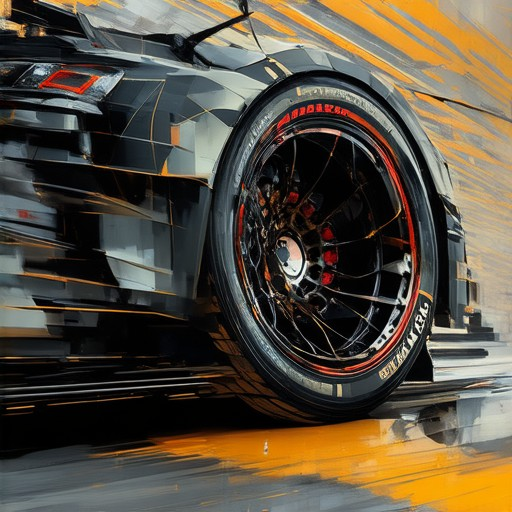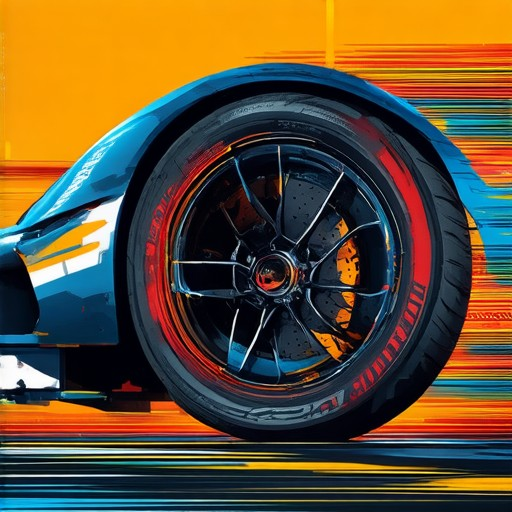Racing has always been a game of precision, and when it comes to performance, every component matters—especially the tires. Whether you’re hitting the dirt tracks, burning rubber on the street, or dominating the drag strip, the right racing tire options can mean the difference between crossing the finish line first or second. With so many choices out there, it can feel overwhelming to pick the perfect set. But fear not! In this guide, we’ll walk you through everything you need to know about racing tire options, from the types of tires designed for different surfaces to the factors that influence their performance. We’ll also dive into the best racing tire setups for various vehicles, including trucks, drag racers, and more. Get ready to rev up your knowledge and discover how the right tires can boost your speed and performance!
Key Takeaways
– Boost Performance with High-Performance Tires: Choose from top-rated options like the Michelin Pilot Sport All Season 4 for exceptional grip and stability, the Continental ExtremeContact DWS 06 Plus for superior traction, the Bridgestone Potenza RE980AS+ for ultimate cornering grip, or the Pirelli P Zero All Season Plus for premium performance.
– Bigger Tires Don’t Slower Your Car—They Enhance Performance: Larger tires improve traction and stability, especially in adverse conditions, without affecting actual speed.
– Z-Rated Tires for Ultimate Performance and Control: Opt for Z-rated tires if you demand high-speed handling and reliability, designed for sports cars and trucks requiring exceptional grip and durability.

Racing Tires: Choosing the Best for Performance
For high-speed racing, selecting the right tires is crucial for maximizing performance and control. Here’s a breakdown of the primary types of racing tires:
Slick Tires
Slick tires are the most common choice for racing due to their smooth surface, which maximizes traction and grip. These tires excel on dry tracks, allowing drivers to push their vehicles to the limit with exceptional stability and cornering ability.
Rain Tires
Rain tires are designed for wet conditions and feature deep grooves to channel water away, preventing hydroplaning. They provide excellent grip on damp tracks, making them essential for races held in inclement weather.
Semi-Slick Tires
Semi-slick tires offer a balance between the smoothness of slick tires and the traction of wet tires. They are ideal for tracks that may have light rain or mixed conditions, combining durability with impressive performance.
Radial Tires
Radial tires, known for their strong sidewall support, are often favored for their improved handling and stability. While they are commonly used in everyday vehicles, specialized racing radial tires can offer even greater precision for competitive racing.
Mixed-Surface Tires
Some races take place on mixed surfaces, such as dirt or gravel tracks. Tires designed for these conditions often feature aggressive tread patterns to maximize grip and provide exceptional durability in varied terrains.
Choosing the Right Tires
The optimal choice depends on the race conditions. For dry circuits, slick tires are usually dominant, while rain or mixed conditions may require wet or semi-slick tires. Always consider the track layout and weather forecast to make the best decision.
At Incubus Wheels, we understand the importance of every detail in achieving peak performance. Our Racing Series tires are engineered to deliver the ultimate driving experience, combining precision and durability for intense competition. Elevate your racing experience with tires designed to dominate the track.
Explore our Racing Series tires and discover the difference made by high-performance components.
What is an option tire in racing?
An option tire in racing refers to specialized tires designed for specific segments of a race, offering a strategic advantage in terms of performance and durability. These tires are typically used under controlled conditions to maximize speed during certain phases of the race, such as short bursts or specific track sections.
Key Characteristics of Option Tires:
- Performance : Option tires often deliver superior grip and traction initially, allowing drivers to maintain higher speeds over shorter distances.
- Durability : Unlike primary tires, option tires may wear out faster due to their aggressive tread design, limiting their use to specific portions of the race.
- Strategic Placement : Teams strategically deploy option tires during pit stops to optimize performance during critical moments, such as when leading or chasing opponents.
Why Are Option Tires Used?
- Short-Duration Performance : Ideal for tracks with long straightaways or sections requiring maximum speed.
- Pit Strategy Optimization : Allows teams to switch to option tires during pit stops to gain a competitive edge.
- Weather Conditions : Often used in wet or slippery conditions where increased grip is needed.
Example Usage:
In a NASCAR Cup Series race, a team might swap to option tires during a pit stop if they anticipate a segment of the track where their primary tires would lose significant grip. This allows them to maintain higher speeds, potentially gaining positions on competitors.
Trade-offs:
- Advantages : Increased speed over shorter distances, improved handling in certain conditions.
- Disadvantages : Reduced longevity of the tire, requiring precise timing and execution in pit strategies.
By leveraging the unique characteristics of option tires, racetracks and teams can tailor their approach to maximize performance during specific segments, showcasing the strategic depth inherent in motorsport engineering.

Racing Tire Compound Explained
Racing tires utilize specialized compounds to optimize performance on the track. Among these, the R-compound (Racing) is a popular choice due to its exceptional initial grip and heat resistance.
- R-Compound Basics: Designed for high-speed performance, R-compound tires feature a unique tread pattern and softer rubber, allowing for increased traction during cornering.
- Heat Management: The compound becomes stickier as it heats, enhancing grip on tracks that become warmer during races.
- Durability Considerations: While offering superior performance, R-compound tires may have a shorter lifespan compared to street tires due to their softer composition.
When selecting the best compound, consider factors like temperature range, durability, and specific track conditions. Manufacturers often offer various series (e.g., Hoosier, Mickey Thompson) with different compounds suited for particular tracks and driving styles.
Ultimately, the ideal compound combines excellent grip with sufficient durability, ensuring optimal performance without compromising safety. Drivers should consult with experts or check manufacturer guidelines to select the best fit for their racing needs.

What Are the Best Tires for Going Fast?
When it comes to finding the best tires for speed, our team at Incubus Wheels has done the research to bring you the top options available. Whether you’re looking for maximum performance on the track or everyday driving with high-speed capabilities, these tires are designed to deliver exceptional speed and handling.
Here are our top recommendations:
- Michelin Pilot Sport All Season 4: Known for its excellent balance of performance and comfort, this tire offers precise grip and stability at high speeds. Its advanced tread design ensures consistent braking performance, making it ideal for both track days and daily commutes.
- Continental ExtremeContact DWS 06 Plus: A favorite among performance drivers, this tire excels in both wet and dry conditions. Its Black Chili Technology enhances responsiveness and provides superior traction, making it a great choice for aggressive driving styles.
- Bridgestone Potenza RE980AS+: Designed with racing heritage, this tire delivers ultimate performance on the street. Its sporty tread pattern maximizes contact with the road, providing excellent cornering grip and straight-line acceleration.
- Pirelli P Zero All Season Plus: Renowned for its premium construction, this tire combines luxury with high-speed performance. Its specialized tread design optimizes aerodynamics and provides confident handling at speeds.
If you’re looking to upgrade your ride, visit us at Incubus Wheels to explore our full collection of performance tires and accessories. Our experts are here to help you find the perfect fit for your vehicle and driving style.
Bigger Tires and Speed: What You Need to Know
When considering whether bigger tires make your car faster or slower, it’s essential to understand the relationship between tire size, speed, and performance.
Tire size, measured by its aspect ratio (e.g., 205/60), determines both the tire’s width and its radius. A larger tire increases the circumference, meaning each revolution covers more distance. This leads to two main effects:
- Speedometer Reading: Since the speedometer calculates speed based on wheel rotations, a larger tire will result in fewer rotations over the same distance. This makes the speedometer underreport your actual speed, giving the impression of being slower.
- Actual Speed: While the speedometer may show a lower speed, the actual speed remains the same. The difference lies in how the car’s speed is perceived and measured.
However, bigger tires offer benefits beyond just speed perception. They provide improved traction, especially in adverse conditions, and can support greater loads. In certain vehicles like trucks or SUVs, larger tires enhance stability and performance on uneven terrain or during heavy-duty tasks.
In summary, bigger tires don’t inherently make your car slower; they affect how speed is measured and provide practical advantages for specific driving scenarios. Whether you choose larger tires depends on your vehicle’s intended use and performance needs.

Z-Rated Tires
Z-rated tires are a designation used to describe tires that meet specific performance criteria, typically related to their ability to handle high-speed driving, heavy loads, or challenging weather conditions. These ratings are often determined by independent testing organizations and provide consumers with a clear indication of a tire’s capabilities.
The Z-rating, sometimes referred to as the ZR rating, was originally developed by the U.S. Department of Transportation (DOT) as part of their tire safety standards. This rating evaluates a tire’s performance in terms of tread depth, durability, and resistance to heat buildup, ensuring they can maintain optimal traction and stability under demanding conditions.
Tires with a Z-rating are designed for vehicles that require exceptional handling, such as sports cars, trucks, and high-performance motorcycles. They often feature wider tread patterns and reinforced sidewalls to enhance stability and prevent punctures during aggressive driving maneuvers.
When selecting Z-rated tires, consider the specific needs of your vehicle. Factors such as intended use (e.g., racing vs. daily commuting), vehicle weight, and local driving conditions play a crucial role in determining the right choice. Always consult the manufacturer’s guidelines or trusted automotive experts to ensure compatibility and safety.
By choosing Z-rated tires, drivers can enhance their vehicle’s performance, particularly in high-speed scenarios or on uneven terrain. These tires are built to last longer and provide better grip, making them a wise investment for serious drivers seeking peak efficiency and control.




0 Comments